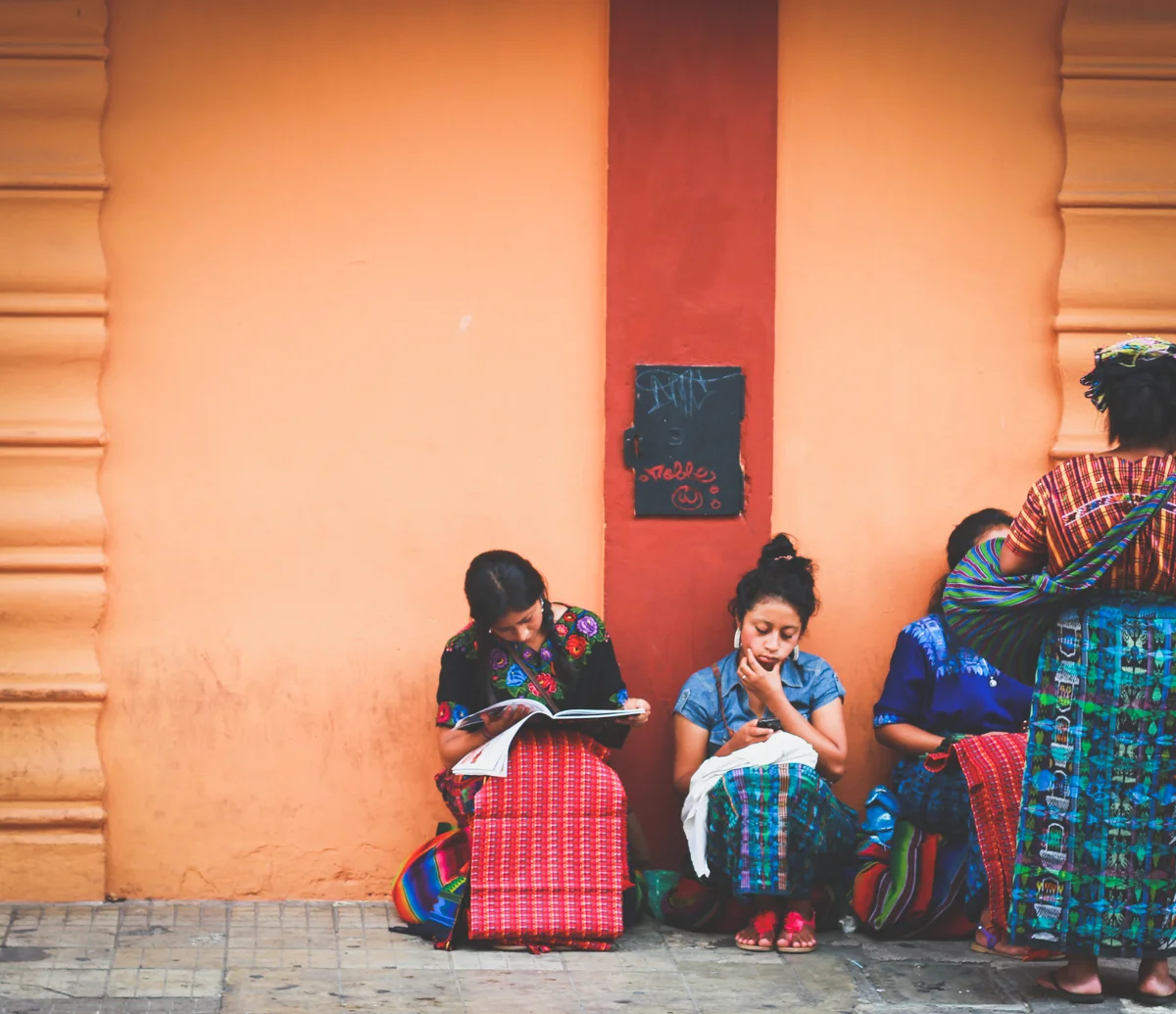Pivotal to our trip was the hope to learn another language. If not fluently, then at least functionally. We would happily settle for being the gringos whose curious accent and idiosyncratic usage of Spanish locals find oddly compelling.
With our 2-year itinerary commencing in Central America, undertaking a Spanish school in Guatemala was a no-brainer. The country has an excellent pedagogical reputation, some of the cheapest classes in Latin America and a choice of stunning locations to base yourself for a few weeks.
Initially, our plan was to learn in Quetzaltenango (Xela) - the choice of more serious students, rather than those wanting to learn the basics by day and drink tequila shots off of a fellow traveller's stomach by night. Antigua, we had initially decided was rather too touristy for a true immersion experience, and whilst this is true, the colourful streets and colonial charm of this beautiful city won us over. Add this to the fact that it was low season so a good deal could be struck at some of the best schools. After a day spent hunting deals and checking out the different courses on offer, we decided on Antigüeña Spanish Academy.
For our tips on selecting the best language school for you, please see our related article.
our period of study
25th May – 6th June. 10 days of school in total, 4 hours of 1-on-1 tuition per day.
setting
Antigüeña is split between two locations. The office was in a building that housed a small number of individual classrooms, replete with whiteboards, wifi and text books. Your first lesson usually takes place here, but most students choose to continue their studies in the second location, a walled garden 15 minutes walk away.
The garden is, in reality, the grounds to an impressive property with three covered terraces facing a well manicured garden. It is peaceful, quiet and, on a sunny day, quite beautiful.
Students share a small table with their teacher amongst the trees or under cover. Despite the number of students and close proximity of tables, the other lessons around you do not feel intrusive or encroach upon your own learning.
Unfortunately, one week of our teaching was marred by a severe storm, and we would really have preferred to study in the classrooms. However, space limitations means that only a few students will be able to do this.
If you are there during rainy season, the garden loses some of its charm, but it is an excellent opportunity to meet other students.
Nevertheless, Antigüeña does give you the option of two very comfortable locations inside and out, which is not something all schools in Antigua can do.
teaching
'English teacher' is one of the most common jobs in Antigua, so the guarantees of experience and ability given by Antigüeña is reassuring; the school is authorised by INGUAT and the Ministry of Education.
There is no formal testing, rather your teacher will assess your level at the beginning of your first lesson. There is quite a clear syllabus for beginners covering verb conjugation (past and present), useful phrases, sentence construction, adverbs and more nouns than you can shake a stick at. Thankfully our teachers were more than willing to diversify lessons and engage in spontaneous conversations and subject, rather than sticking too stringently to grammatical necessities.
The most positive aspect of the teaching experience is that, in the 1-on-1 format, you are responsible for how and how much you learn. Our separate lessons did not follow identical trajectories or timetables, but this is because the teacher is able to adjust lessons to based on individual abilities and interests. This is in contrast to the language teaching style most commonly experienced in the U.K where a large group takes precedence.
Given this, if you have preferred learning style (i.e. prefer interaction to learning by rote or vice versa, activities over 'call-and-response'), it is important that you make this clear to your teacher early on.
If, despite this, you still don't feel like you're getting what you need at Antigüeña, they are open to you changing teacher and in fact, if you are studying long-term, they recommend you change every 2-3 weeks.
Classes traditionally commence at 8a.m., but late-risers can request a start time of 8.30/9 a.m. In addition, be aware that you have a 30-minute break during your lesson.
activities
Like many schools, Antigüeña offers its students afternoon activities for social, linguistic and cultural progression. These started at 2 p.m and were usually completed by 4/5 p.m.
The school is transparent about all costs, and every activity was included in our weekly fee. Some other schools we approached, despite having higher weekly costs, still required some additional money for any half decent activity.
Led by a teacher(s), activities on offer during our two week stint included:
- Visit to local macadamia nut farm
- Cooking class
- Spanish scrabble
- Basketball
- Walking tour of the city
- Tour of the city's ruins
- Visit to the Cross on the Hill.
- Visit to a coffee farm
For us, the best aspect of the activities was that they were led in clear Spanish by a teacher. However, we often chose to study privately, rather than join all activities.
extras
During morning lessons, you have access to free coffee and filtered water. Wi-fi is available in the main building, as well as access to a library. If you're looking for a quiet study environment, you can also use the main office's classrooms in the afternoon (depending upon availability).
social projects
A number of long-term students select their school based upon the volunteering opportunities available. Many language schools will also have an affiliation to a particular social project. Unfortunately, such projects are not available via Antigüeña.
home-stays
As we chose private accommodation over a home-stay, we cannot comment too much on this. However, we met a lot of students partaking in a home-stay, and the majority were very happy with this choice, which includes 3-meals a day excluding Sunday.
It is advisable however, to ask how many other students will be staying with your family, as some people were a little disappointed that gringos outnumbered family members, thereby making the supposed 'immersion' experience, less of a reality.
long-term accommodation
If studying for a week or longer, you will often be able to secure reductions at your hostel or seek out a short-term let.
We were very fortunate that the family who own the school also had an apartment available next door. We secured this for two weeks, at a nightly cost less than a room at most hostels, and were delighted with it.
Very private and secure with a hot shower, good-wifi, cable T.V., a large bedroom and well kitted out living room/kitchen - it gave us everything we needed.
If you are studying here, especially as a couple, we highly recommend you ask about its availability.
budget options
Given its excellent reputation, we were pleasantly surprised at the competitive fee we negotiated with Julio. However, for those looking to reduce costs further, consider taking your lessons in the afternoon. Although no activities are included, you can save up to $20 per week.
If travelling with a friend or partner, it may also be worth considering joint classes, but be aware this may (drastically) alter you learning experience!
top tips
Some excellent food is available during your break. Our favourite was the doblados available for 3 GTQ outside the garden entrance. Fried and folded tortilla, filled with cheese, meat or potato, topped with fresh guacamole, salad and salsa were an excellent source of additional energy for the last 2 hours of class. Inside the school, there is also a stand with cheap sandwiches and snacks.
If studying in the garden, the fantastic local market is also only 5 minutes walk away.
For study materials, there is stationery store opposite the main office, which has 100 blank flash cards for 3 GTQ. An alternative is the large supermarket 5 minutes from Central Park.
Total Costs
The original price offered, per student for 4 hours a day for five days, was $120 USD. However, this was negotiated down to $95.
Longer classes are available too. The original (negotiated) prices quoted were:
$130 ($115) – 5 hours/day
$160 ($130) – 6 hours/day
Afternoon classes:
$100 ($77) - 4 hours/day
$110 ($90) - 5 hours/day
Rates are likely to be at the upper-end, and less negotiable, in high season (Dec-Mar, June-August)
Was it worth it?
You really do get out, what you put in. We both enjoyed our classes and the learning environment, but also put in quite a lot of work after school, in addition to the set homework. As you're trying to get to grips with vast sections of a new language, only 'learning' in your 4 hours might lead to you feeling disappointed at your progression.
Overall, we had high hopes for our first language school, and viewed it as pivotal to giving us a solid foundation for the rest of our trip and Antigüeña met our expectations.


















